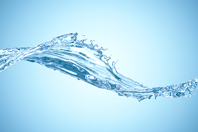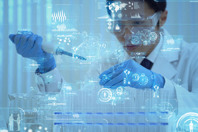WATER INDUSTRY FEATURES, INSIGHTS, AND ANALYSIS
-
PFAS In Pregnant Women's Drinking Water Puts Their Babies At Higher Risk, Study Finds
When pregnant women drink water that comes from wells downstream of sites contaminated with PFAS, known as “forever chemicals,” the risks to their babies’ health substantially increase, a new study found. These risks include the chance of low birth weight, preterm birth, and infant mortality.
-
PFAS Settlements: Debunking The Myths And Revealing What's Really At Stake For Water Utilities Misinformation and confusion could prevent some utilities from benefitting from the aqueous film-forming foam multidistrict litigation (AFFF MDL) settlements. Here are five common myths about the AFFF MDL PFAS settlements and how public water systems can make the most of this unprecedented funding opportunity.
-
When Chemistry Meets Water Innovation
Nobel-winning molecular materials are poised to reinvent purification, desalination, and reuse.
-
Solving The World's Microplastics Problem: 4 Solutions Cities And States Are Trying After Global Treaty Talks Collapsed
Microplastics seem to be everywhere — in the air we breathe, the water we drink, the food we eat. Countries have tried for the past few years to write a global plastics treaty that might reduce human exposure, but the latest negotiations collapsed in August 2025. While U.S. and global solutions seem far off, policies to limit harm from microplastics are gaining traction at the state and local levels.
-
AEC System Proven Effective For Chloride Removal
In two bench-scale tests, a new technology effectively removed up to 99% of chlorides and 97% of total dissolved solids in a single pass. This solution offers a commercially viable alternative to traditional treatment methods.
-
Common Misconceptions Are Keeping Lakes "Sick"
Long-held misconceptions about lake management fuel the intensity and recurrence of harmful algal blooms.
-
Colorado's Subalpine Wetlands May Be Producing A Toxic Form Of Mercury — That's A Concern For Downstream Water Supplies
The wetlands found across the Rocky Mountains of Colorado just below tree line are crucial for regulating the supply of clean water from the highlands to metropolitan regions downslope, including Denver. However, new research shows the wetlands also harbor a health risk.
-
Grand Canyon's Dragon Bravo Megafire Shows The Growing Wildfire Threat To Water Systems
As wildfire crews battled the Dragon Bravo Fire on the Grand Canyon’s North Rim in July 2025, the air turned toxic. A chlorine gas leak had erupted from the park’s water treatment facility as the building burned, forcing firefighters to pull back. The water treatment facility is part of a system that draws water from a fragile spring. The fire also damaged some of the area’s water pipes and equipment.
-
What Are Legionella Log Books And Why Are They Important? Implementing and managing a Legionella control regime can sometimes seem daunting and complex. Invariably, a lot of resources, time, and effort are needed to achieve the required standard and provide assurance to senior management and auditors that controls are effective and those that are not are being managed and rectified appropriately.
-
How ABB's Flow And Digital Technologies Help Bawat With Smarter Ballast Water Compliance
The International Maritime Organization (IMO) sets strict global standards for ballast water management to prevent the spread of harmful aquatic organisms. For companies like Bawat, a Danish innovator in ballast water management, being able to verify ballast water flow measurements quickly, accurately, and from anywhere in the world is essential.
VIEWS ON THE LATEST REGS
-
With the U.S. EPA's PFAS rules now in place, utilities are finding themselves with a growing number of questions regarding how to treat these chemicals, the potential costs, and much more. For answers, Water Online's chief editor, Kevin Westerling, hosted an Ask Me Anything session featuring Ken Sansone, Senior Partner at SL Environmental Law Group; Kyle Thompson, National PFAS Lead at Carollo Engineers; and Lauren Weinrich, Principal Scientist at American Water.
-
A Q&A to explain and resolve issues confronting water suppliers as they endeavor to comply with the monitoring requirements of federal PFAS regulations.
-
Assessing what lies ahead in the 10-year race to go lead-free, otherwise known as the Lead and Copper Rule Improvements (LCRI).
-
Many water systems are still tackling the challenge of identifying and compliantly managing galvanized and galvanized-requiring-replacement (GRR) service lines.
-
In the most recent edition of Water Innovations, there is not a single article focused on PFAS. That wouldn't be exceptional if not for the fact that discussion around per- and polyfluoroalkyl substances has so thoroughly dominated the water space lately. And yet, I penned this as an intro to the edition — just "a tiny bit of PFAS" content — because a small portion of PFAS is of the utmost importance in terms of treatment, policy, and cost.
MORE WATER INDUSTRY FEATURES
-
BlueConduit recently submitted comments to the EPA on the proposed Lead and Copper Rule Improvements (LCRI). We are committed to achieving a lead-free drinking water system through evidence-based decision making and applaud the EPA for establishing a timeline for the replacement of all lead service lines in the United States.
-
This application note explores a test which demonstrated significant improvements in Oil-in-Water monitoring of industrial wastewater in comparison to the weekly grab sample analysis method.
-
Achieving stable, homogeneous membrane protein samples for cryo-EM is challenging. Learn critical quality control insights from Dr. Melanie McDowell, covering everything from nanodiscs to lysis techniques.
-
Explore a validated LC-MS/MS method for precise Semaglutide quantification in plasma, which features enhanced sensitivity, peak definition, and reproducibility using innovative technologies.
-
Ion exchange (IX) is a tried-and-true method of removing metals and other inorganic compounds from water. Arsenic, cadmium, chromium, copper, lead, nickel, selenium, radionuclides, and zinc are just a few examples of the compounds that our ion exchange systems have removed from water.
-
In an example using rituximab and its biosimilars, explore the significance of minor differences of glycosylation in antibodies and its impact on their properties and functionality.
-
Leveraging real-time data, these systems can provide critical information, which helps maintain regulatory compliance and reduce the risk of quality shifts that can impact customers.
-
As water scarcity and energy costs rise, new ultrafiltration membrane technologies deliver higher flux, longer lifespan, and reduced fouling—turning water treatment from a compliance task into an efficiency opportunity.
-
Perfluoro compounds (PFCs), which are suspected carcinogens, are a growing concern for communities and a challenge that many water utilities need to address. When the Stratmoor Hills Water District detected PFCs in a seasonal well, the utility partnered with Evoqua, a Xylem company, to find a cost-effective solution.
-
Ozone is a vital pre-treatment for PFAS mitigation. It oxidizes precursors and co-contaminants, significantly extending the service life of downstream GAC and membrane systems.
-
In this article, Transcend will highlight the importance of EPA PFAS drinking water standards as well as how they ensure safe and clean water systems. We also provide the opportunity to streamline wastewater design for utilities, engineering consultants, and equipment suppliers.
-
Rising city populations, high consumption of resources, ageing infrastructure, climate change, complex Water Distribution Systems — these are but a few issues forcing those in city management to rethink their sustainability and efficiency efforts. Underlying each is the question of clean water management, and how water utilities can be empowered to make informed decisions in the face of the issues combined.
-
Implementing NGS technology for adventitious virus testing in viral vector vaccine development and manufacturing is crucial for ensuring safety. Gain insights for an optimized sequencing method.
-
In a world where access to clean and safe water is increasingly vital, AquaKnight emerges as the steadfast guardian of clean drinking water in the ongoing battle against PFAS.
-
Learn about the significance of sensitivity in drug development and how researchers can improve their pipelines by employing more sensitive models.
-
In this article, take a look at a few non-traditional ROI considerations when thinking about a new technology purchase.
-
We talk a lot about ‘compliance’ but the reality is that compliance is complicated and changes over time. This series breaks down compliance requirements across the LCR and the proposed LCRI to help you understand the who, what, and when of compliance.
-
Take a closer look into research aimed at enhancing the cryogenic freezing process of the mammalian CHO-K1 cell line using a controlled-rate liquid nitrogen freezer.



































